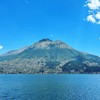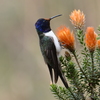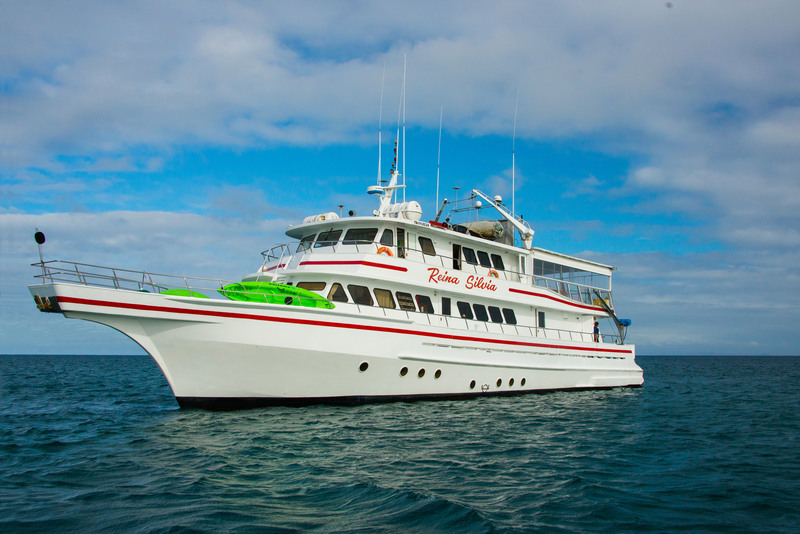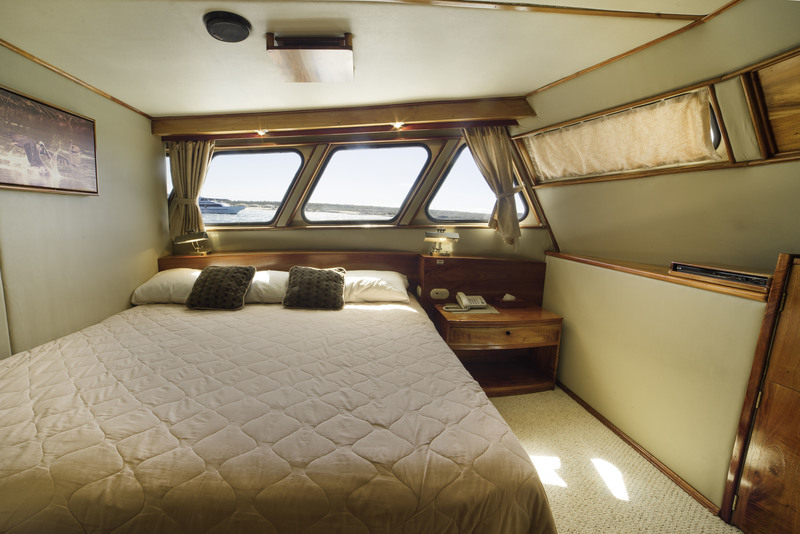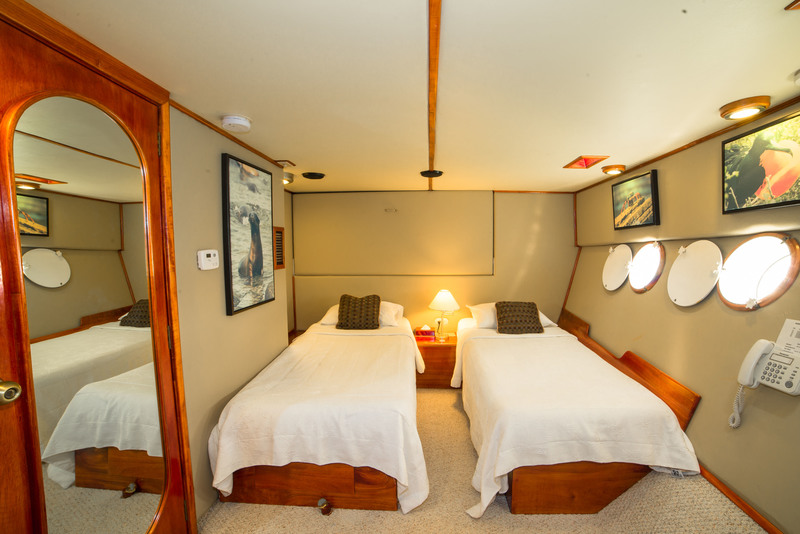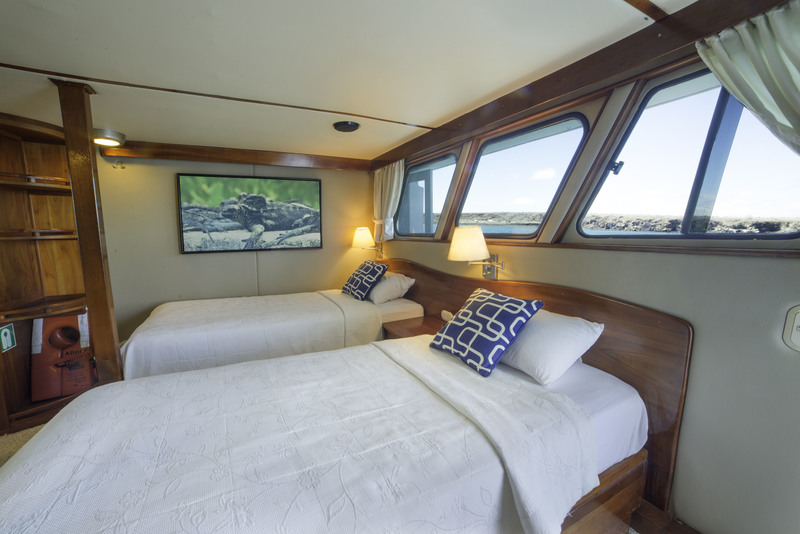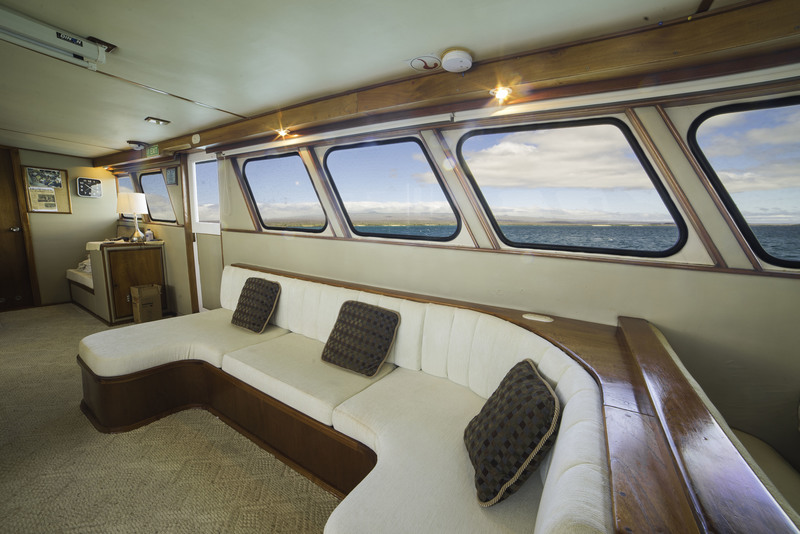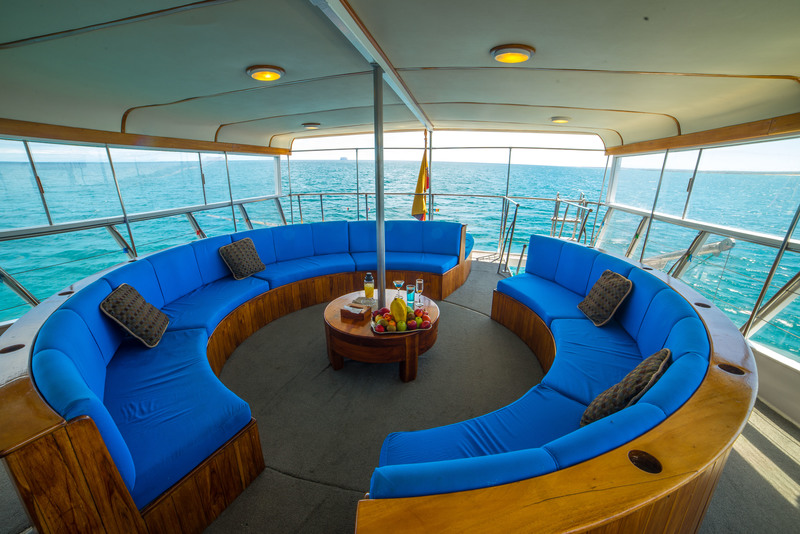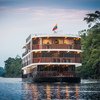Day 1 (Saturday)
MORNING FLIGHT FROM QUITO OR GUAYAQUIL TO BALTRA (GALAPAGOS) TWIN CRATERS & FAUSTO LLERENA BREEDING CENTER.- Assistance at the airport by our representatives for your Galapagos flight. You will arrive at the airport on Baltra Island in the morning and after going through immigration and baggage claim, you will be met by guide from the Reina Silvia. You will have lunch at a local restaurant and visit the Twin Craters located opposite to each other on both sides of the road leading from Puerto Ayora to Baltra. The name is only figurative; not real craters, these formations were created by the collapse of surface material in underground fissures and chambers. The view is breathtaking.
The afternoon visit is the “Fausto Llerena” breeding center where giant tortoises are bred in captivity and reared until the age of 5 years, when they can survive the effects of introduced predators. This is home to tortoises ranging from 3-inches (new hatchlings) to 4-foot long adults. Subspecies of the giant tortoises interact with one another, and many of the older tortoises are accustomed to humans stretching out their heads for a photo opportunity.
Day 2 (Sunday)
FLOREANA: CORMORANT POINT / CHAMPION/POST OFFICE BAY / ASILO DE LA PAZ.- Cormorant Point hosts a large flamingo lagoon where other birds such as common stilts and whitecheeked pintails can also be seen. The beaches on this island are distinct: The Green Beach is named so due to its green color, which comes from a high percentage of olivine crystals in the sand, and the Four Sand Beach is composed of white coral.
Afterwards, you will visit Champion Islet, named after the whaler Andrew Champion, is a small island located just offshore Floreana Island in the southern part of the Archipelago, considered as one of the most beautiful places on Galapagos for all snorkeling and diving fans and an excellent opportunity for dolphin watching.
After lunch, you will visit the famous Post Office Bay. You will land on the beach and head to a spot where 18th century whalers placed a wooden barrel for use as an unofficial mail box. The custom continues to this day with Galapagos visitors. So do not forget your postcards, and do not be surprised if the post card arrives to its destination before you even get home!
In the afternoon, you will visit The Asilo de la Paz. This is a hill 450m high that is behind Straw Hill in the agricultural area of the island. The main attractions are of a historic type: one is the cave of pirates and the other is the freshwater spring. The two sites are located at the base of the hill.
Day 3 (Monday)
ISABELA: MORENO POINT / ELIZABETH BAY.- In the morning you will visit Moreno Point, located southwest of Elizabeth Bay. Here a dry landing onto what was once flowing lava is possible. The lava has left craters in its wake which formed crystal tide pools. By looking into the pools, you can peer into another world as the marine life drifts by your window. In the brackish pools of this area, you may see pink flamingos, white-cheeked pintails, and common gallinules. If you look carefully into the pools, you may see white-tip reef sharks and some sea turtles.
In the afternoon, you will visit Elizabeth Bay, which is located on the east coast of Isabela Island. The bay contains many islets, which can be visited by dinghy. Penguins and blue-footed boobies can be spotted on the rocky islets. With an abundance of marine life and clear water, the area is perfect for snorkeling and viewing schools of colorful fish, sea lions, and perhaps even sharks.
Day 4 (Tuesday)
ISABELA AND FERNANDINA: URBINA BAY / ESPINOZA POINT In the morning, you will land at Urbina Bay which presents some fascinating geological formations. In 1954, an uplift from the sea formed the bay which has been characterized by the resulting terrestrial coral reef ever since. Expect to see stingrays and sea turtles swimming near the surface of the water along with flightless cormorants, pelicans, and marine iguanas. You will be dazzled by the breathtaking view of the Alcedo Volcano.
In the afternoon, you will land at Espinosa Point and after walking past a colony of marine iguanas and a group of sea lions, you’ll reach the island’s highlight: the flightless cormorant nesting site. This area also provides a great opportunity to see the Galapagos hawk.
Day 5 (Wednesday)
ISABELA: TAGUS COVE / VICENTE ROCA POINT.- After breakfast, you will visit Tagus Cove which is located across from Fernandina Island, near the Bolivar Channel dividing the two islands. This spot has been frequented by ships since the 1800s, using the area as an anchorage site. Trails winding by Lake Darwin up to a ridge display wonderful views. Punta Tortuga, just north of Tagus Cove, is another lovely beach surrounded by mangroves.
The afternoon visit is at Vicente Roca Point. Comprised of two separate coves, this site is a large bay with spectacular sea life. Keep an eye out for seahorses, sea turtles, and the strange yet fascinating Mola mola (or sunfish).
Day 6 (Thursday)
ESPUMILLA BEACH / BUCCANEER COVE / EGAS PORT / SALT MINES.- In the morning you will start visiting Espumilla Beach where marine iguanas lounge and the Sally Lightfoot crabs attract the hunting herons performing the dance of predator and prey right before your eyes. Snorkeling is highly recommended as you could find yourself face to face with an octopus, moray eel, shark and a variety of other species of tropical fish.
Next you will visit Buccaneer Cove which is a testament to the fact that Santiago Island was once a refuge for British buccaneers. These pirates would anchor in the protected bay to make repairs and stock up on tortoise meat among other things. The steep cliffs, where hundreds of seabirds perch in front of the dark red sand beach, are a magnificent site.
After lunch, you will go to Egas Port, also known as James Bay, on Santiago Island which is home to the curious Galapagos hawks and quick-footed Galapagos lava lizards. The trail leads to the coastline with gorgeous tide pools and grottos full of fauna. Here the Galapagos fur sea lions bathe in the sun. This is also a great snorkeling site.
Later in the afternoon you will visit the Minas de Sal, located northwest of Santiago Island. The trail has an approximate distance of 8 km. round-trip. This site has an important history from the year 1683 when William Ambrose Cowley visited this place, it was he who gave the name of James to the Bay and the island there have been many travelers who have visited this place to exploit this natural resource and salted beef and fish.
Day 7 (Friday)
BACHAS BEACH / NORTH SEYMOUR.- The morning visit to Bachas Beach which is located on the north shore of Santa Cruz and is a swimming beach. One of the few remnants of the U.S. World War II presence in the Galapagos, a floating pier, can be seen here. You may see flamingos, Sally Lightfoot crabs, hermit crabs, black-necked stilts, and whimbrels. Sea turtles also nest on the beach.
In the afternoon, you will visit North Seymour. Here you will be able to see Galapagos sea lions, bluefooted boobies and magnificent frigate birds which are abundant on the Island. The island was formed by a series of submarine lava flows containing layers of sediment that were uplifted by tectonic activity. The island is characterized by its arid vegetation zone.
Day 8 (Saturday)
BALTRA.- After breakfast, you will be transferred from the boat to the Baltra airport for your flight to Guayaquil or Quito.



